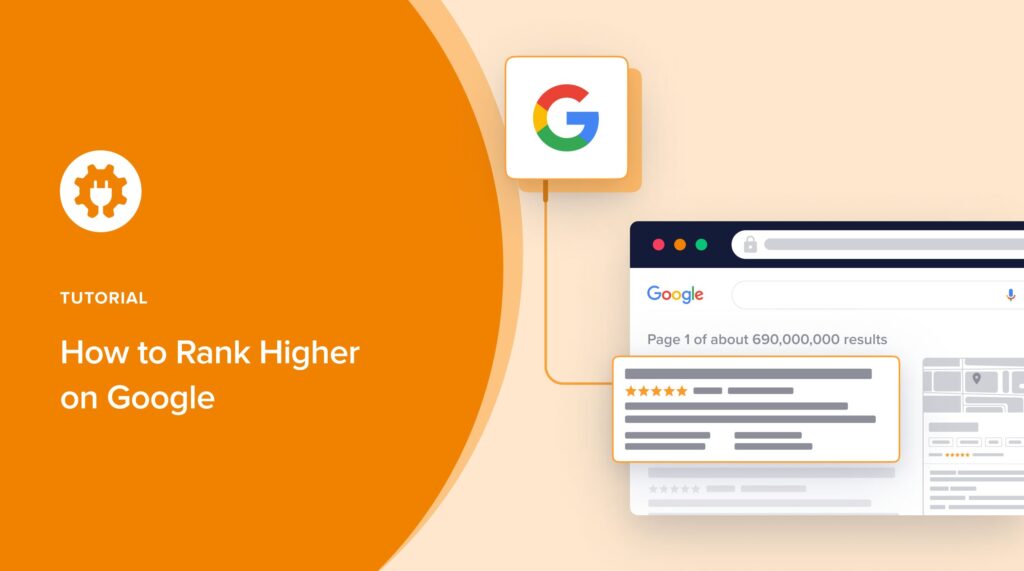Learning how to rank higher on Google can transform your online efforts.
With billions of Google searches every day, being on the first page for valuable search terms can propel sales and revenue.
This article provides tested ways to rank higher on Google.
The good news is many of the steps are based on common sense. For instance, you’ll:
- Make your content easy to read and useful
- Study websites that already rank well in Google
- Optimize your pages so Google understands them better
- Get other websites to link to yours
As you take action, more people will find and visit your site. Implementing even a few of these tips can accelerate your wins.
The first step is to understand Google’s goals.
In This Article
Think of Google as a Librarian
Google is like a librarian. Librarians organize books by topics and subjects. This makes it easy for visitors to find what they’re looking for.
A librarian might also draw attention to popular books by creating special displays.
Similarly, Google ranks web pages by relevance to search queries. Pages that answer the search well are displayed at the top. And some web pages get featured in special displays like “featured snippets” and “People Also Ask” questions.
The outcome is the same. Both Google and the librarian make it easier for people to get the information they want.
Whether you search Google or go to the library, being able to find what you want quickly is the goal.
What Are Google Ranking Factors?
It also helps to keep in mind some of Google’s ranking factors.
Quality is the #1 Google ranking factor. Shortly, we’ll explain how to pick keywords well and how to plan your content so you reach quality goals.
Backlinks (links from other sites to yours) are another significant factor. In Google’s eyes, backlinks indicate that others value your content.
If you have a local business, some unique factors come into play. An optimized Google Business Profile and good Google Review ratings can elevate your business in local search results.
We’ll cover local SEO in more depth below.
Let’s get started.
How to Rank Higher on Google (14 Steps)
Ranking higher on Google starts with getting a basic understanding of what keywords are. You’ll discover interesting ways to create quality content that satisfies searchers and gets Google’s attention.
And you’ll optimize your page before publishing it.
Ready?
1. Understand Keyword Basics
It’s common to hear site owners say “I want my website to rank high.” But websites don’t rank: individual web pages do.
When a page ranks high, it ranks for specific keywords. Keywords are the same thing as search terms (also called search queries). These are the words or phrases people enter into search engines.
So the first step to ranking well on Google is to determine which keyword(s) you want a page to rank for.
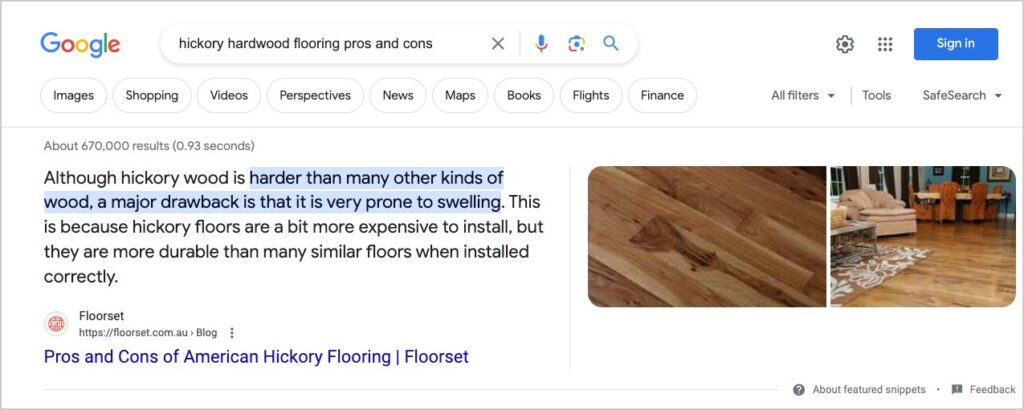
If you’re starting out, we recommend you target one keyword. Keep in mind that most pages that rank, wind up ranking for multiple keywords.
Later in this article, under the measurement section, we’ll explain how to find out which keywords you’re ranking for.
Next, let’s look at how you can maximize your chances of ranking by choosing keywords well.
2. Pick Keywords (Topics) that are Easy to Rank for
Some keywords are nearly impossible to rank for. No matter how much content you create to target those keywords, you may never rank.
To avoid disappointment, and make progress, choose keywords that are easy to rank for.
The idea is new to many site owners. Learn how to find easy keywords.
That tutorial will walk you through how to use a keyword research tool that assigns a keyword difficulty label to every keyword. These labels range from “Very easy” to “Difficult.”
Your job? Pick keywords labeled “Easy” or “Very easy.”

Choosing easy keywords will not only help you begin ranking, it will elevate the overall authority of your website, making it easier to rank for more difficult terms in the future.
3. Choose Buyer Intent Keywords
Did you know you can choose keywords that signal buying intent?
The searcher using these keywords may be in the early stages of buying and exploring “how-to” articles to solve a problem. Others may be on the brink of buying.
Example of buyer intent keywords are:
- Geico vs. Progressive
- Best WordPress form plugins
- Brazilian teak hardwood flooring
So how do you find these keywords? Use a keyword research tool like Semrush. For each keyword entered you’ll see a “keyword intent” label.
Only Commercial or Transactional keywords signal buying intent.
| Intent label | Stands for: | Explanation | Examples |
|---|---|---|---|
| I | Informational | Keywords where the user is seeking information, trying to research a topic. | ‘how to lose weight’, ‘symptoms of diabetes’ |
| N | Navigational | Keywords where the user is trying to find a specific website or webpage. | ‘wikipedia’, ‘cnn news’ |
| C | Commercial | Keywords where the user is looking to buy a product or service. | ‘best cappuccino makers’, ‘signNow vs DocuSign’, “budget home cleaning services” |
| T | Transactional | Keywords where the user intends to make an immediate purchase or transaction. | ‘book Bahamas cruise from Tampa’, ‘buy SEO plugin’ |
Best of all, you can choose buyer intent keywords that are easy to rank for.
Learn more in our tutorial on buyer intent keywords.
4. Identify Search Intent
After you’ve picked your easy-to-rank-for keyword, it’s time to do a bit more research.
You’re going to discover the search intent behind the keyword. If you used Semrush, you’ve already got a clue. You have the keyword intent label. But there’s more to find out.
Search intent is the motivation and mindset of searchers, as revealed by Google. Searcher intent might be a better name for this.
The easiest way to explore search intent is to use Chrome Incognito.
Incognito is the privacy-based version of Chrome.
Here’s how to open Chrome in Incognito mode:
- Mac: Press Shift + Command (⌘) + n
- Windows, Linux, or Chrome OS: Press Ctrl + Shift + n.
Next, enter your keyword.
Take a look at the top-ranking pages on Google. See any patterns?
Formatting: For instance, are most of the top-ranking articles step-by-step tutorials (common for “how-tos”)? Or are they all listsicles (common for “best of” articles). What Google rewards can be an indication of what users expect.
People Also Ask: Next, explore the People Also Ask questions. This is a search feature that appears for many (but not all) keywords. Here you’ll find the most common questions people have on your topic. Plan to answer some of these questions in your article.

These are 2 simple ways you can ensure your article satisfies searchers.
After you’ve chosen a keyword and scoped out search intent, you’re ready for the next step.
5. Improve on #1
You’ll need to come up with at least 1 way your page will be better than those ranking at the top. Remember, rankings are competitive. And if you want to dislodge the current top pages, you’ll need to create something better.
Better can be simple.
To get your creative thinking going, here are some flaws we’ve found in top-ranking articles. Next to each we’ve listed ways you could take advantage of these flaws to produce something better.
| Flawed aspect | Better approach |
|---|---|
| Rambling, long introduction | Short, enticing introduction |
| Uses jargon | Written in “plain English” |
| Goes off-topic, hard to follow | Create an outline before writing, to keep content focused on main topic |
| Filled with typos | Review before publishing |
| Low-resolution images | High-resolution images |
| Inaccurate information | Fact-check article, include links to sources |
6. Create High-Quality Content
Quality is the #1 Google ranking factor. Catering to search intent, answering some People Also Ask questions in your content, and picking 1 way to improve on top-ranking articles, will put you in good stead.
Before you begin, think about what a searcher would hope to accomplish by reading your page. How can you make it easier for them to accomplish their goal?
Reviews: If you’re reviewing products, show that you’ve actually used them. This can be done by including relevant screenshots or videos. This credibility in reviewing is key to ranking.
Experience: First-hand experience is a form of expertise that is valued on Google. The same principle that applies to reviews also applies to other content, like travel blog posts. A post that features images or video and a first-person account of travel will likely be more valued by searchers (and rank higher) than an article that simply recycles what the author read elsewhere.
Trustworthiness: Take care to be accurate. When citing statistics, for example, link to the original source.
Google puts a big emphasis on what it calls EEAT signals: this refers to Experience, Expertise, Authority, and Trustworthiness.
In our next section we’ll include a way you can highlight your EEAT for readers and search engines.
It’s time to turn our attention to optimizing your page before publishing it.
7. Optimize Your Page for Better Ranking
Optimizing your page (also called on-page SEO) can help Google understand your content better so it can rank it for relevant keywords.
WordPress users can use an SEO plugin. This simplifies SEO and makes it easy for beginners to do.
We recommend All in One SEO (AIOSEO). The plugin will analyze your pages and show you what to do to improve SEO.
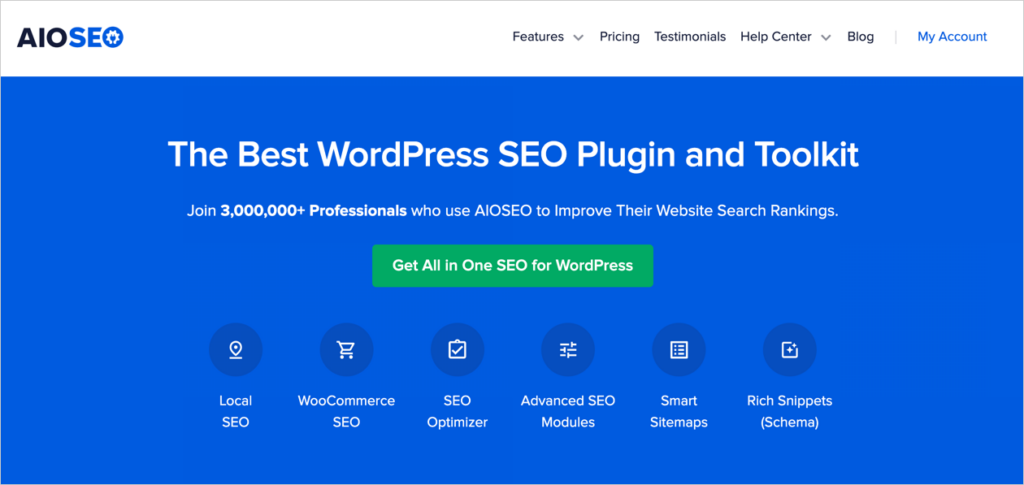
It also automatically handles technical SEO tasks like generating and updating sitemaps.
All in One SEO is an established plugin with thousands of 5-star reviews on WordPress.org. Currently, over 3 million people are using the plugin.
After downloading and installing the plugin, navigate to a web page that you want to optimize. AIOSEO will appear as a right-hand sidebar.
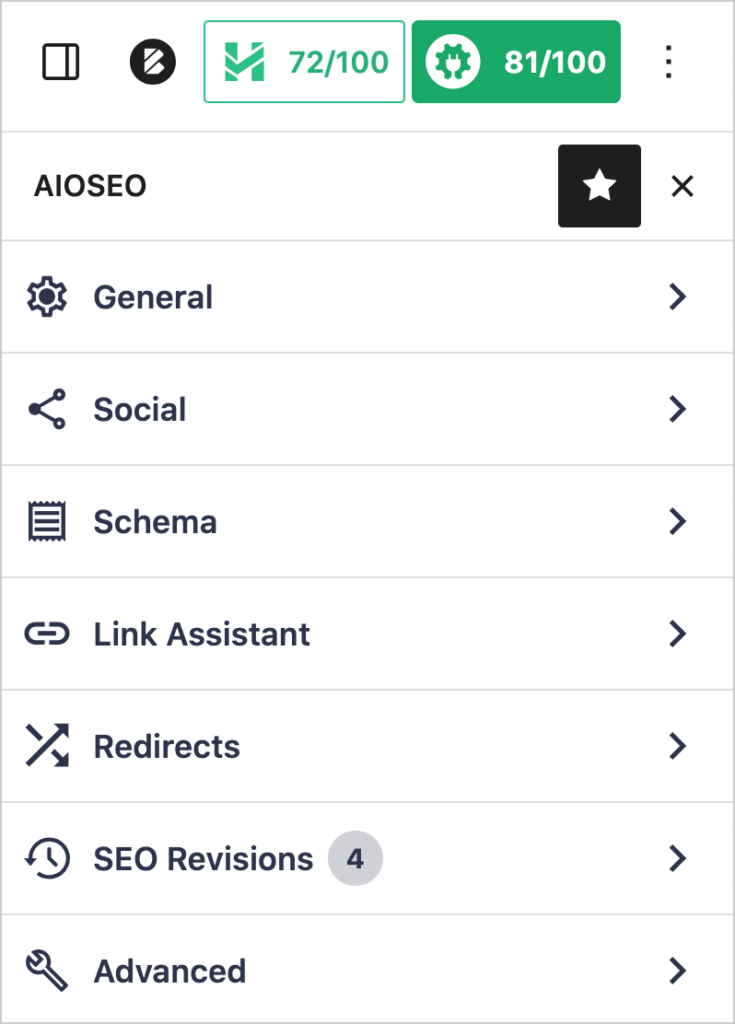
The plugin will run several checks on your page. For example, it’ll check your focus keyword (target keyword) use.
Specifically, it’ll check to see if you used your keyword in:
- Title (also called an SEO title or title tag)
- Description (also called a meta description)
- First paragraph
- Some subheadings
This helps ensure your page topic is clear to Google and to readers.
If your keyword’s missing from any of these areas, you’ll be prompted to add it.

All in One SEO also runs checks for readability and good formatting.
Other features you can use to improve ranking include:
- Link Assistant: The Pro version of AIOSEO includes a Link Assistant which speeds up internal linking.
- Schema Generator: With a few button clicks you can add code called schema markup to your pages. This helps Google better understand your content and surface it for relevant queries.
- Author SEO: Fill out a form listing your education, experience, and areas of expertise. AIOSEO will generate an attractive author byline and bio, which can help signal EEAT. Optional: Add a second byline for a reviewer or fact-checker.

We’ve focused primarily on individual web pages. Now, let’s turn our attention to issues that may affect your site as a whole.
8. Fix Broken Links
Some broken links on a website are normal and Google doesn’t consider 404s to be a problem per se.
But having lots of broken links can lead to diminished rankings. Also it creates a poor user experience because people can’t find what they’re looking for.
If you’re having issues with broken links consider using a Broken Link Checker to find and fix these links.
9. Improve Page Experience
Page experience is a Google ranking factor and rolls together several things like page speed, site security, and how well your site functions on a mobile device.
Page speed is something of a relative ranking factor. If competing pages all load in roughly the same speed, then quality is going to influence rankings more than speed.
You can use Google’s PageSpeed Insights to get diagnostics for your site. But be aware: it takes some technical knowledge to understand and act on the tool’s suggestions. WordPress users would be wise to simply switch to a theme that loads fast and works well on all devices.
SeedProd is a WordPress landing page and website builder that is coded to load fast.
10: Get Backlinks
Backlinks are a significant Google ranking factor. But they only help you if they’re from trustworthy sites.
So don’t pay for backlinks: paid links are typically from spammy operations and can harm your SEO.
The good news is quality content attracts links. People naturally want to share useful and interesting content.But you can also ask for links. To do this, identify some sites that might be interested in what you’re publishing. Then simply request a link.
You can pitch them by email. Make the pitch short. Show you understand their readership.
Inboxes are overflowing with link request emails. Most are written poorly and many are created with fake identities.
Write a classy email and use your real name. You’ll stand out.
11. Measure and Improve
After creating and optimizing your content, you’ll want to measure results.
Google Analytics: Google Analytics is a free tool that will provide you with plenty of traffic, conversion, and revenue data. Setting Google Analytics up for ecommerce tracking takes some effort, but there are plenty of free tutorials online.
Analytics, simplified: WordPress users can install MonsterInsights, which simplifies Google Analytics use and displays relevant data right inside the WordPress dashboard.
Track keyword rankings: Want to know which keywords you’re ranking for? Try the Elite version of All in One SEO (AIOSEO). Thanks to its integration with Google Search Console, you can track your progress without leaving WordPress.
This AIOSEO feature is called Search Statistics. It will also help you see which pages are slipping in rankings so you can prioritize improving those.
Prune your content garden: We all wind up with underperforming pages. This is where content pruning comes in.
Sometimes you can combine several underperformers (on the same topic) into one comprehensive article that ranks well.
Other times you may want to delete the really poor performers or content that’s no longer relevant to your goals. But check that page traffic first in Google Analytics. And don’t forget to redirect to a better page before deleting.
Local SEO Tips for Small Businesses
To rank well in local search results, businesses need to do a few extra things.
The good news is these 3 steps are incredibly easy. And each one is recommended by Google in its guidance on improving local rankings.
12. Optimize Your Google Business Profile
The first step is to create and optimize a Google Business Profile. When people search for your business, they’ll see a prominent display thanks to this profile.
Information from your profile will appear in many areas of Google Search, including in Google Maps and in the new AI feature. This improves your online visibility.
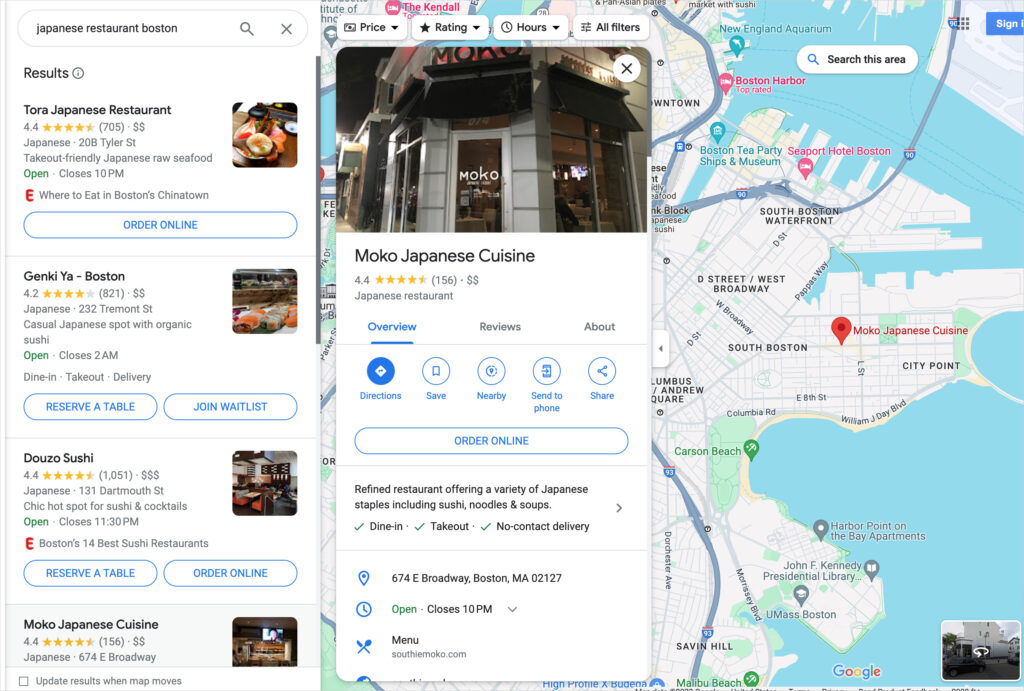
Google Business Profile was cited as the #1 local ranking factor in a recent survey of marketers.
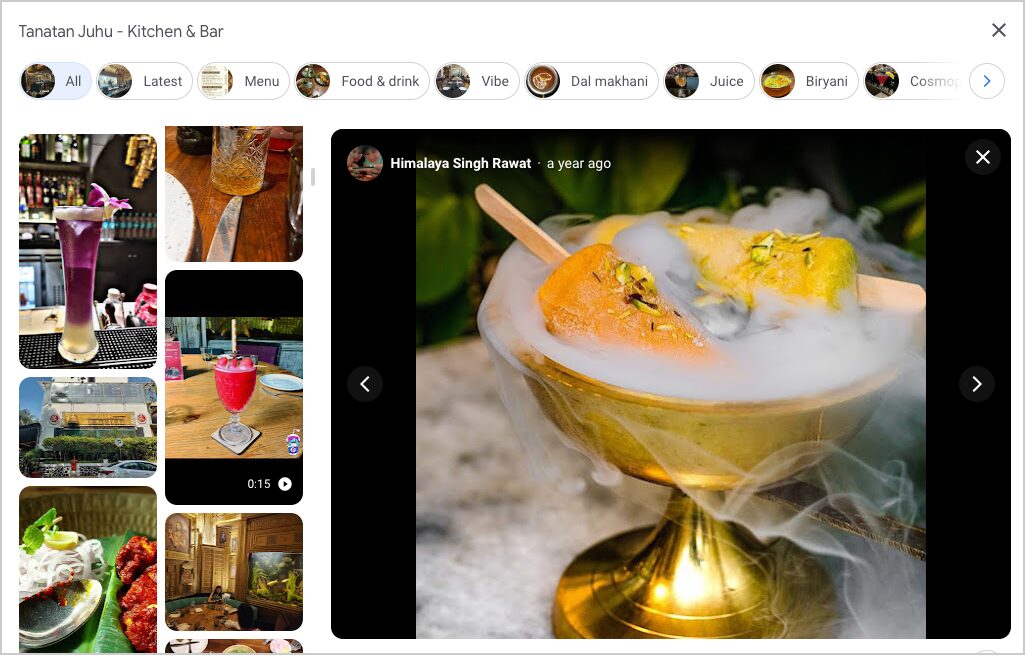
13. Get Google Reviews
When customers review your business on Google Reviews, the results will show up on your profile.
Searchers can see your average star rating, number of reviews, and reviewer comments.
These review ratings show up all over the internet. So it’s to your advantage to ask for reviews and respond quickly to them.
The biggest mistake is to stop asking for new reviews. Research shows that shoppers consider recency of reviews when trying to choose between 2 businesses.
Learn how to manage Google Reviews for improved SEO.
You’ve got this. It isn’t hard. And don’t fret about negative reviews. Research shows consumers find a mix of reviews to be more trustworthy.
14. Obtain Business Directory Listings
When a business is mentioned on several different websites it can give consumers confidence it’s legitimate.
So it’s not surprising that getting your business listed in relevant online directories is a local ranking factor.
This is one of the easiest steps you’ll ever take for SEO.
You can use a low-cost service to get the listings for you. Then if your contact information or hours of operation change, you can ask the service to update the listings too.
These listings are sometimes referred to as citations and the line gets blurred between directories, Google Business Profile, social media profiles, as well as local chambers of commerce listings.
They’re all good for your online visibility.
Find out how to get business directory listings. And read our guide on why keeping your business information consistent across the web is critical for local rankings.
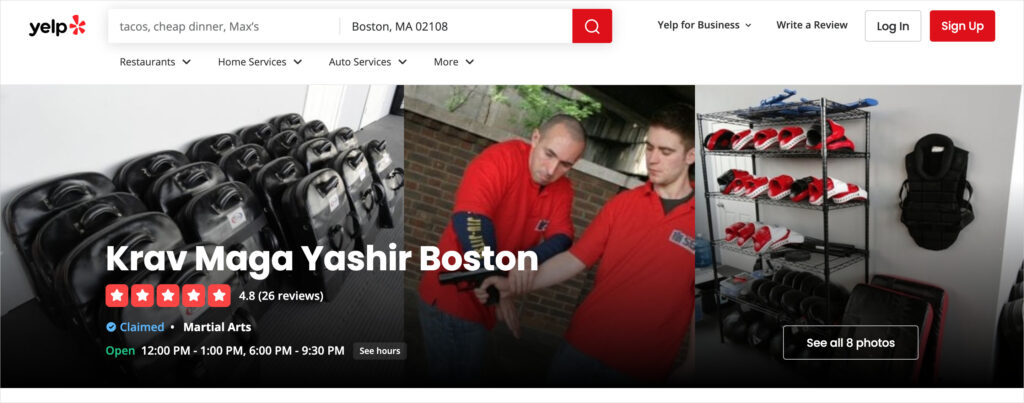
Scammers love pitching small businesses on local directory listings. Learn how to avoid SEO scams.
Q&A on How to Rank Higher on Google
Almost everyone wants to understand how to rank higher on Google. And this attracts lots of questions.
We’ve answered some of the most common ones below. If you have an additional question, drop it in the comments section below this article. We’d be delighted to be of assistance.
How can I rank #1 on Google?
To rank #1 on Google you’ll need to determine which search term (keyword) you want to rank for. Then you’ll need to create content that is better than the web page currently in the #1 spot. To do this you’ll need to understand what Google considers to be high-quality content and you’ll need to satisfy search intent better than the top-ranking pages.
Can you pay Google to rank higher?
No, you can’t pay Google to rank higher in organic search results. However, you can buy Google Ads which appear at the top of search pages. Since the space for these ads isn’t unlimited, your ad will likely compete with others for impressions. This means your ad won’t be seen at the top by everyone who searches for the related keyword(s).
Service-based businesses can use Google’s Local Services Ads to appear at the top of search results as well. These ads offer pay-per-lead pricing: you only pay for leads that connect directly through the ad itself.
Can I do SEO without paying?
Yes, you can do SEO without paying a professional. However, most DIY SEO incurs a modest cost. For instance, if you have a WordPress website and use an SEO plugin, you can rapidly optimize pages without dealing with code.
To get an idea of cost, the All in One SEO (AIOSEO) starts at $49.60 a year. (This is an established plugin with thousands of 5-star reviews on WordPress.org.)
How do I rank higher on Google Maps?
To rank higher on Google Maps (and the Local Pack) follow Google’s advice on how to improve your local ranking. The search giant emphasizes creating and optimizing a Google Business Profile, managing Google Reviews well, and getting listed in business directories.
In addition, it’s crucial to post accurate hours of operation, and update those if/when they change. Learn more about how accurate business information can impact your rankings.
How to improve your Google rankings without getting penalized?
To improve your Google rankings without getting penalized, learn what activities Google penalizes. In short, avoid black hat SEO techniques like keyword stuffing and link schemes.
Be skeptical of all shortcuts to higher rankings, like paying for dofollow backlinks.
What’s the easiest thing someone can do to boost their SEO?
There are a few easy things you can do to boost SEO. First, pick a topic (keyword) that’s easy to rank for. Secondly, create the best content you can on that topic. Lastly, use an SEO plugin to speed up web page optimization.
Next SEO Steps
Now that you know how to rank higher on Google, what’s next?
Learn how to use topic clusters to accelerate SEO results. Then explore how to combine email marketing and SEO to boost revenue.
Come join us on our YouTube Channel to find simple WordPress SEO tutorials. You can also follow us on X (Twitter), LinkedIn, or Facebook to stay in the loop.
Disclosure: Our content is reader-supported. This means if you click on some of our links, then we may earn a commission. We only recommend products that we believe will add value to our readers.
